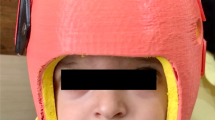Abstract
Minimally invasive, endoscopic repair of metopic craniosynostosis has emerged as a potentially efficacious, safe, and aesthetically acceptable alternative to open procedures. Potential advantages of an early endoscopic approach to repair metopic craniosynostosis include a reduction in blood loss and consequent decreases in transfusion volumes, decreased hospital costs, shorter operative times, and limited duration of hospitalization. Other benefits of minimally invasive techniques would be avoidance of anaesthetic surgical scarring, decrease in postoperative swelling and discomfort, and lower rate of complications such as duramater tears, postoperative hyperthermia, or infection. However, a concern is usually raised about the achievements of the “endoscopic” techniques when compared to “standard” open approaches. The indications for endoscopic-assisted surgery in the treatment of trigonocephaly remain controversial and further series and follow-up of these patients are necessary to set up the role of these approaches.





Similar content being viewed by others
References
Barone CM, Jimenez DF (1999) Endoscopic craniectomy for early correction of craniosynostosis. Plast Reconstr Surg 104:1965–1973
Cohen SR, Holmes RE, Ozgur BM, Meltzer HS, Levy ML (2004) Fronto-orbital and cranial osteotomies with resorbable fixation using an endoscopic approach. Clin Plast Surg 31:429–442
Di Rocco C, Velardi F, Ferrario A, Marchese E (1996) Metopic synostosis: in favour of a “simplified” surgical treatment. Child's Nerv Syst 12:654–663
Di Rocco C (2003) How to decrease the impact of surgical scar in the correction of sagittal synostosis. Child's Nerv Syst 19:42–45
Esparza J, Hinojosa J (2008) Complications in the surgical treatment of craniosynostosis and craniofacial syndromes: apropos of 306 transcranial procedures. Child's Nerv Syst 24:1421–1430
Hinojosa J, Esparza J, Muñoz MJ (2007) Endoscopic-assisted osteotomies for the treatment of craniosynostosis. Childs Nerv Syst 23:1421–1430
Jimenez DF, Barone CM, Cartwright CC, Baker L (2002) Early management of craniosynostosis using endoscopic-assisted strip craniectomies and cranial orthotic molding therapy. Pediatrics 110:97–104
Jimenez DF, Barone CM (2007) Early treatment of anterior calvarial craniosynostosis using endoscopic-assisted minimally invasive techniques. Childs Nerv Syst 23:1411–1419
Jimenez DF, Barone CM (2010) Endoscopic techniques for craniosynostosis. Atlas Oral Maxillofac Surg Clin North Am 18:93–107
Jimenez DF, Barone CM (2010) Multiple-suture nonsyndromic craniosynostosis: early and effective management using endoscopic techniques. J Neurosurg Pediatr 5:223–231
Keshavarzi S, Hayden MG, Ben-Haim S, Meltzer HS, Cohen SR et al (2009) Variations of endoscopic and open repair of metopic craniosynostosis. J Craniofac Surg 20:1439–1444
Kim D, Pryor LS, Broder K, Gosman A, Breithaupt AD et al (2008) Comparison of open versus minimally invasive craniosynostosis procedures from the perspective of the parent. J Craniofac Surg 19:128–131
Mehta VA, Bettegowda C, Jallo GI, Ahn ES (2010) The evolution of surgical management for craniosynostosis. Neurosurg Focus 29:E5
Meier PM, Goobie SM, DiNardo JA, Proctor MR et al (2010) Endoscopic strip craniectomy in early infancy: the initial five years of anesthesia experience. Anesth Analg 112:407–414
Murad GJ, Clayman M, Seagle MB, White S et al (2005) Endoscopic-assisted repair of craniosynostosis. Neurosurg Focus 19:E6
Persing JJ (2004) Endoscopy-assisted craniosynostosis. Neurosurg 100:403–404, discussion 404-6
Stelnicki EJ (2002) Endoscopic treatment of craniosynostosis. Atlas Oral Maxillofac Surg Clin North Am 10:57–72
Teichgraeber JF, Baumgartner JE, Waller AL, Reis SM et al (2009) Microscopic minimally invasive approach to nonsyndromic craniosynostosis. J Craniofac Surg 20:1492–1500
Tobias JD, Johnson JO, Jimenez DF, Barone CM, McBride DS Jr (2001) Venous air embolism during endoscopic strip craniectomy for repair of craniosynostosis in infants. Anesthesiology 95:340–342
van der Meulen J, van der Hulst R, van Adrichem L, Arnaud E et al (2009) The increase of metopic synostosis: a pan-European observation. J Craniofac Surg 20:283–286
Author information
Authors and Affiliations
Corresponding author
Rights and permissions
About this article
Cite this article
Hinojosa, J. Endoscopic-assisted treatment of trigonocephaly. Childs Nerv Syst 28, 1381–1387 (2012). https://doi.org/10.1007/s00381-012-1796-7
Received:
Accepted:
Published:
Issue Date:
DOI: https://doi.org/10.1007/s00381-012-1796-7




